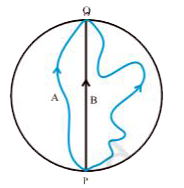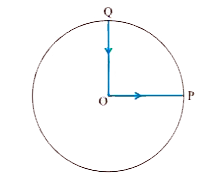Complete Solutions to EXCERCISES of chapter MOTION IN A PLANE of Class 11 book with complete answers and questions
| Class 11 | PHYSICS |
| Chapter | MOTION IN A PLANE |
| NCERT TELUGU | EXCERCISES |
| Number Of Questions | 30 |
| Academic Year | 2023-24 |
State , for each of the following physical quantities , if it is a scalar or a vector : volume , mass , speed , acceleration , density , number of moles , velocity , angular frequency , displacement , angular velocity .
View SolutionPick out the two scalar quantities in the following list : force , angular momentum , work current , linear momentum , electric field , average velocity , magnetic moment , relative velocity.
View SolutionPick out the only vector quantity in the following list : Temperature , pressure impulse , time , power , total path length , energy , gravitational potential , coefficient of friction , charge .
View SolutionState with reasons , whether the following algebraic operations with scalar and vector physical quantities are meaningful :
(a) adding any two scalars , (b) adding a scalar to a vector of the same dimesions , (c ) multiplying any vector by any scalar , (d) multiplying any two scalars , (e ) adding any two vectors , (f) adding a component of a vector to the same vector .
View SolutionRead each statement below carefully and state with reasons , if it is true of false :
(a) The magnitude of a vector is always a scalar , (b) each component of a vector is always a scalar , (c ) the total path length is always equal to the magnitude of the displacement vector of a particle . (d) the average speed of a either greater or equal to the magnitude of average velocity of the particle over the same interval of time , (e ) Three vectors not lying in a plane can never add up to give a null vector .
View SolutionEstablish the following vector inequalities geometrically or otherwise :
(a) `|a+b|le|a|+|b|`
(b) `|a+b|ge||a|-|b||`
(c ) `|a-b|le|a|+|b|`
(d) `|a-b|ge||a|-|b||`
When does the equality sign above apply ?
View SolutionGiven a+b+c+d=0 , which of the following statements are correct
(a) a,b,c and d must each be null vector ,
(b) The magnitude of (a+c) equals the magnitude of (b+d),
(c ) The magnitude of a can never be greater than the sum of the magnitudes of b ,c and d,
(d) b+c must lie in the plane of and d if a and d are not collinear , and in the line of a and d , if they are collimear ?
View SolutionThree girls skatting on a circular ice ground of radius 200 m start from a point P on the edge of the ground and reach a point Q diametrically opposite to P following different paths as shown in Fig . 4.20 . What is the magnitude of the displacement vector for each ? for which girl is this equal to the actual length of path skate ?

View SolutionA cyclist starts from the centre O of a circular park of radius 1 km , reaches the adge P of the park , then cycles along the circumference , and returns to the centre along QO as shown in Fig . 4.21 . If the round trip takes 10 min , what is the (a) net displacement.
(b) average velocity , and (c ) average speed of the cyclist ?

View SolutionOn an open ground , a motorist follows a track that turns to his left by an angle of `60^(@)` after every 500 m. Starting from a given turn , specify the displacement of of the motorist at the third , sixth and eighth turn . Compare the magnitude of the displacement with the total path length covered by the motorist in each case.
View SolutionA passenger arriving in a new town wishes to go from the station to a hotel located 10 km away on a straight road from the station . A dishonest cabman takes him along a circuitous path 23 km long and reaches the hotel in 28 min . What is (a) the average speed of the taxt , (b) the magnitude of average velocity ? Are the two equal ?
View SolutionRain is falling vertically with a speed of `30 ms^(-1)` . A woman rides a bicycle with a speed of `10 ms ^(-1)` in the north to south direction . What is the direction in which she should hold her umbrella ?
View SolutionA man can swim with a speed of 4.0 km/h in still water . How long does he take to cross a river 1.0 km wide if the river flows steadily at 3.0 km/h and he makes his strokes normal to the river current ? How far down the river does he go when he reaches the other bank ?
View SolutionIn a harbour , wind is blowing at the speed of 72 km/h and the flag on the mast of a boat anchored in the harbour flutters along the N- E direction . If the boat starts moving at a speed of 51 km/h to the north , what is the direction of the flag on the mast of the boat?
View SolutionThe celling of a long hall is 25 m high What is the maximum horizontal distance that a ball thrown with a speed of `40 " ms "^(-1)` can go without hitting the ceiling of the hall ?
View SolutionA cricketer can throw a ball to a maximum horizontal distance of 100 m. How much high above the ground can the cricketer throw the same ball ?
View SolutionA stone tied to the end of astring 80 cm long is whirled in a horizontal circle with a constant speed . If the stone makes 14 revolutions in 25 s , what is the magnitude and direction of acceleration of the stone?
View SolutionAn aircraft executes a horizontal loop of radius 1.00 km with a steady speed of 900km/h. Compare its centripetal acceleration with the acceleration due to gravity .
View SolutionRead each statement below carefully and state , with reasons , if it is true or false :
(a) The net acceleration of a particle in circular motion is always along the radius of the circle towards the centre
(b) The velocity vector of a particle at point is always along the tangent to the path of the particle at that point
(c ) The acceleration vector of a particle in uniform circular motion averaged over one cycle is a nul vector
View SolutionThe position of a particle is given by
`r=3.0hati-2.0t^(2)hatj+4.0hatkm`
where t is in seconds and the coefficients have proper units for r to be in metres .
(a) Find the v and a of the particle ? (b) What is the magnitude and direction of velocity of the particle at `t=2.0s` ?
View SolutionA particle starts from the origin at t=0 s with a velocity of `10.0hatjm//s` and moves in the x-y plane with a constant acceleration of `(8.0hati+2.0hatj) " m s"^(-2)` (a) At what time is the x - coordinate of the speed of the particle at the time ?
View Solution`hatiandhatj` are unit vectors along x - and y- axis respectively . What is the magnitude and direction of the vectors `hati+hatjandhati-hatj`? What are the components of a vector `A=2hati+3hatj` along the directions of `hati+hatjand hati-hatj`? [ You may use graphical method]
View SolutionFor any arbitrary motion in space , which of the following relations are true : (a) `V_("average")=(1//2)(v(t_(1))+v(t_(2)))`
(b) `V_("average")=[r(t_(2))-r(t_(1))]//(t_(2)-t_(1))`
(c ) `V(t)=V(0)+at`
(d) `r(t) =r(0)+v(0)T+(1//2)at^(2)`
(e ) `a_("average")=[v(t_(2))-v(t_(1))]//(t_(2)-t_(1))`
(The average stands for average of the quantity over the time interval `t_(1)" to "t_(2))`
View SolutionRead each statement below acrefully and state , with reasons and examples , if it is true or false : A scalar quantity is one that
(a) is conserved in a process
(b) can never take negative values
(c ) must be dimensionless
(d) does not very from one point to another in space
( e) has the same value for observers with different orientations of axes.
View SolutionAn aircraft is flying at a height of 3400 m above the ground . If the angle subtended at aground observation point by the aircraft positions 10.0 s apart is ` 30^(@)` , what is the speed of the aircraft ?
View SolutionA vector has both magnitude and direaction . Does it mean that anything that has magnitude and direction is necessarily a vector ? The rotation of a body can be specified by the direction of the axis of rotation , and the angle of rotation about the axis . Does that make any rotation a vector ?
View SolutionCan you associate vectors with (a) the length of a wire bent into a loop , (b) a plane are a , (c ) a sphere ? Explain .
View SolutionA bullet fired at an angle of `30^(@)` with the horizontal hits the ground `3.0` km away . By adjusting its angle of projection , can one hope to hit a target `5.0` km away ? Assume the muzzle speed to be fixed and neglect air resistance .
View SolutionA fighter plane flying horizontally at an altitude of 1.5 km with speed 720 km/h passes directly overhead an anti - aircraft gun . At what angle from the vertical should the gun be fired for the shell with muzzle speed `600"ms"^(-1)` to hit the plane ? At what minimum altitude should the pilot fly the plane to avoid being hit ? (Take g=`10 " ms "^(-2))`.
View SolutionA cyclist is riding with a speed of 27 km /h . As he approaches a circular turn on the road of radius 80 m , he applies brakes and reduces his speed at the constant rate of `0.50m//s` every second . What is the magnitude and direction of the net acceleration of the cyclist on the circular turn ?
View Solution
EXCERCISES questions and complete solutions for chapter MOTION IN A PLANE of NCERT PHYSICS(TELUGU) of Class 11